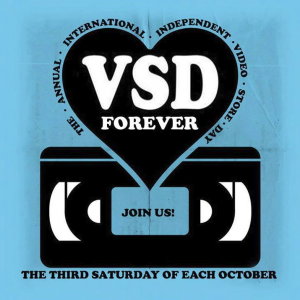If you missed our note about Video Store Day from earlier in the Halloween Countdown, the event’s official Facebook page has all the information you need about the event.
Although most remaining video rental stores focus exclusively on DVD and Blu-Ray, you can sometimes find some which still stock VHS. Many who look back fondly on the days of VHS often wonder why movie cover art has become so different. While covers using photographs weren’t unheard of, painted or drawn artwork used to be the most popular way to go. So what happened? To get a full understanding, let’s take a quick look back at the history of video rentals and poster art.
When the video boom first started, the idea was to attract the most attention to your company’s product as possible. So naturally many video companies decided to make their box art look like painted posters. After all, posters had been done this way since the silent era and could be relied on to draw attention (especially to low budget productions which lacked the star power of films from major studios). This in turn led to the “big box” method of packaging VHS cassettes. This gave more room for the artwork and helped certain movies stand out from those packaged in smaller boxes. This was especially important in attracting the lucrative teen renter market, who often rented multiple movies at the same time. Some companies even put rainbows or other distinctive banners at the top of the box to draw more eyes to their boxes. Such concepts weren’t unlike DC Comics’ “Go-Go Checks” and other artistic methods of attracting readers to their comic books. But somewhere along the line, box sizes shrunk and “sleeves” became the new standard. Money was most likely a factor, especially since some store chose to cut out portions of big boxes to fit them into plastic cases and threw away the rest. Why spend money on something nobody is going to use or see?
But the smaller box size wasn’t the only factor at play. Artistic posters were starting to fall by the wayside (although this might not be case for long). The most common explanation you’ll see online for this is due to changes in contracts for performers. A quick look at articles about “equal likeness” clauses and movie posters shows this isn’t just some internet myth. Not only have poster artists weighed in on the matter, but it’s even been alleged the original poster art for The Rocketeer was phased out of theaters since it didn’t bring enough attention to the stars in the cast! The rise of photo manipulation programs and the presumed lower cost of making artwork that way on computers probably also helped all but completely kill off traditional poster art. Which in turn worked over into the world of home video. This issue is apparently discussed in the documentary 24×36: A Movie About Movie Posters. So you might want to keep an eye out for it during your next trip to your local video store!
Happy Video Store Day!
Special thanks to Eyesore Cinema for use of the image!

